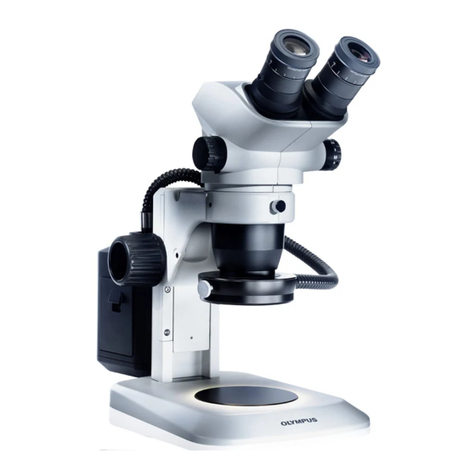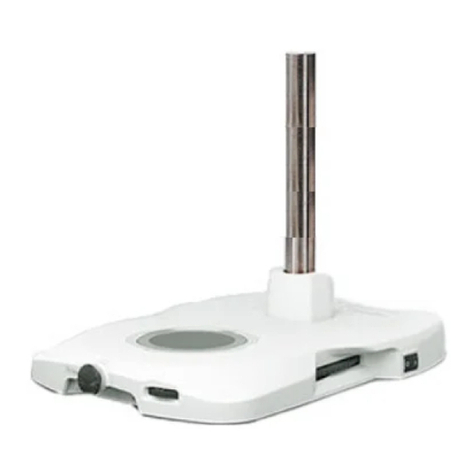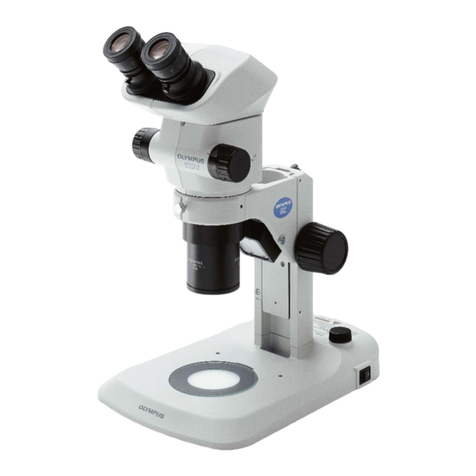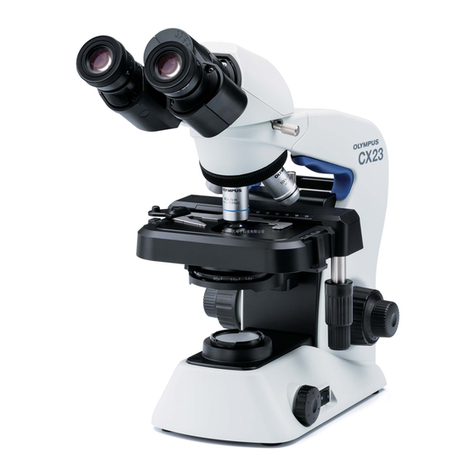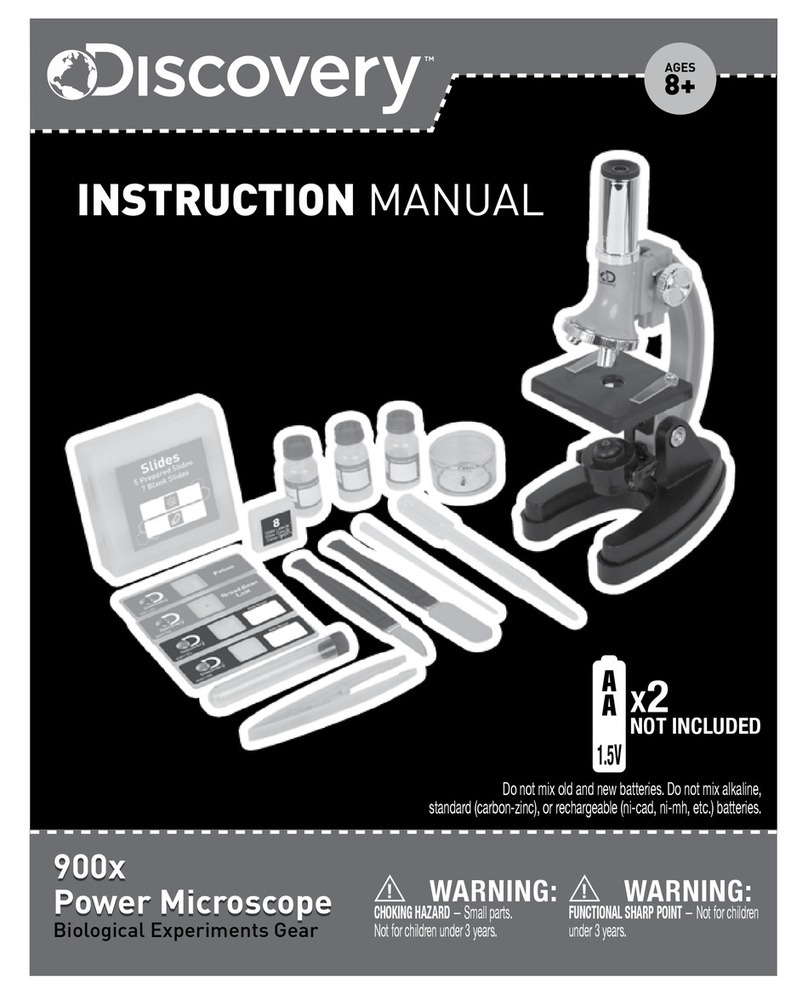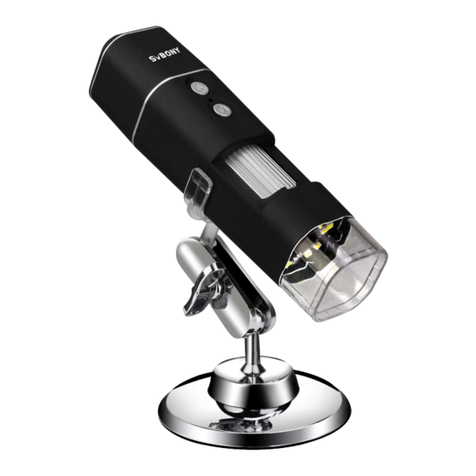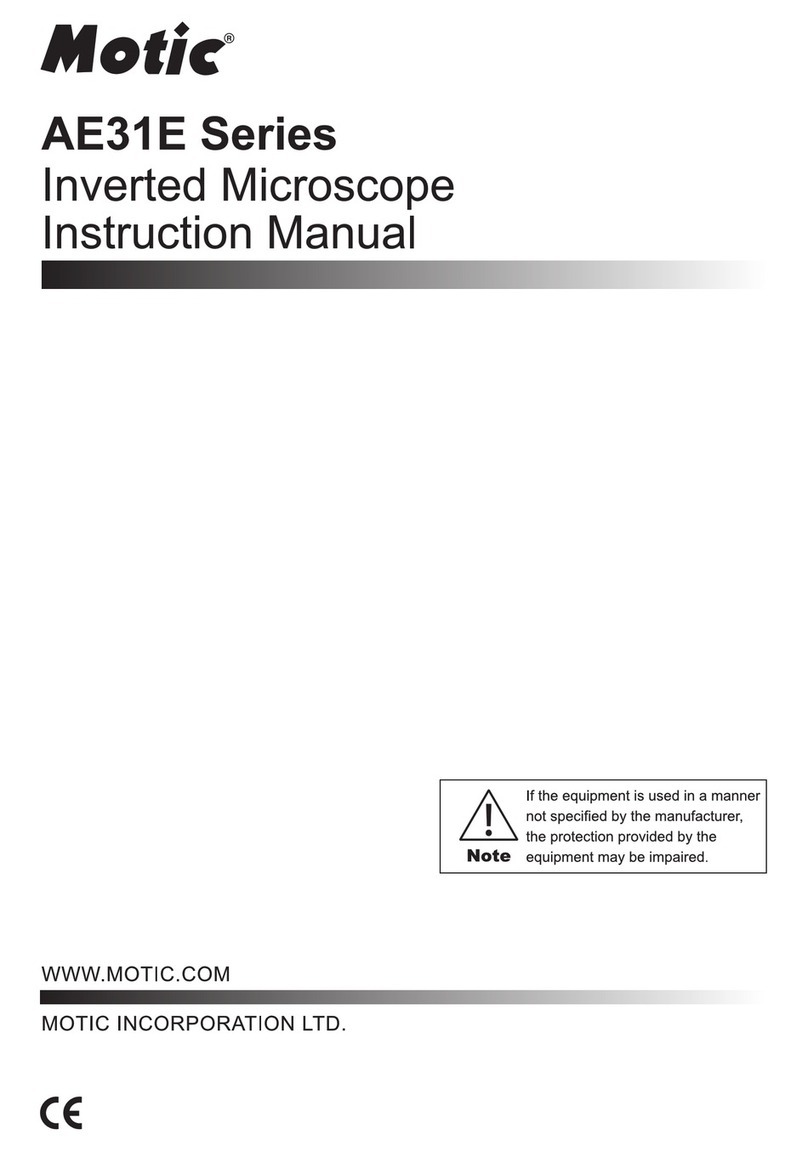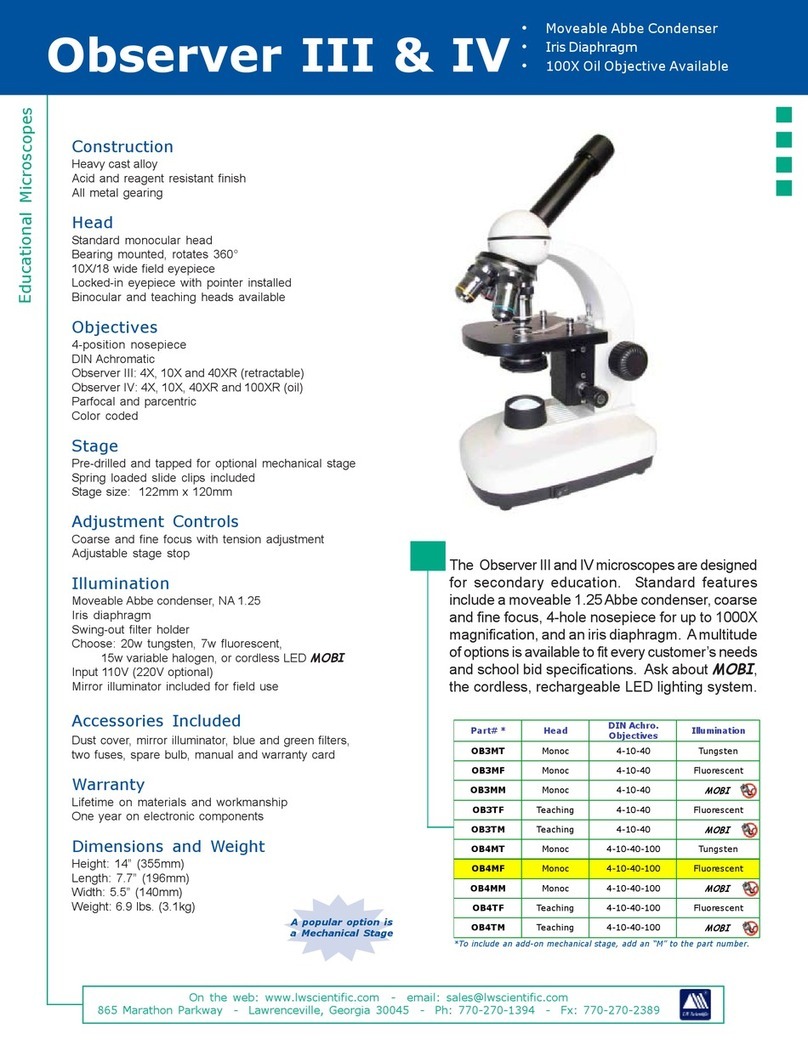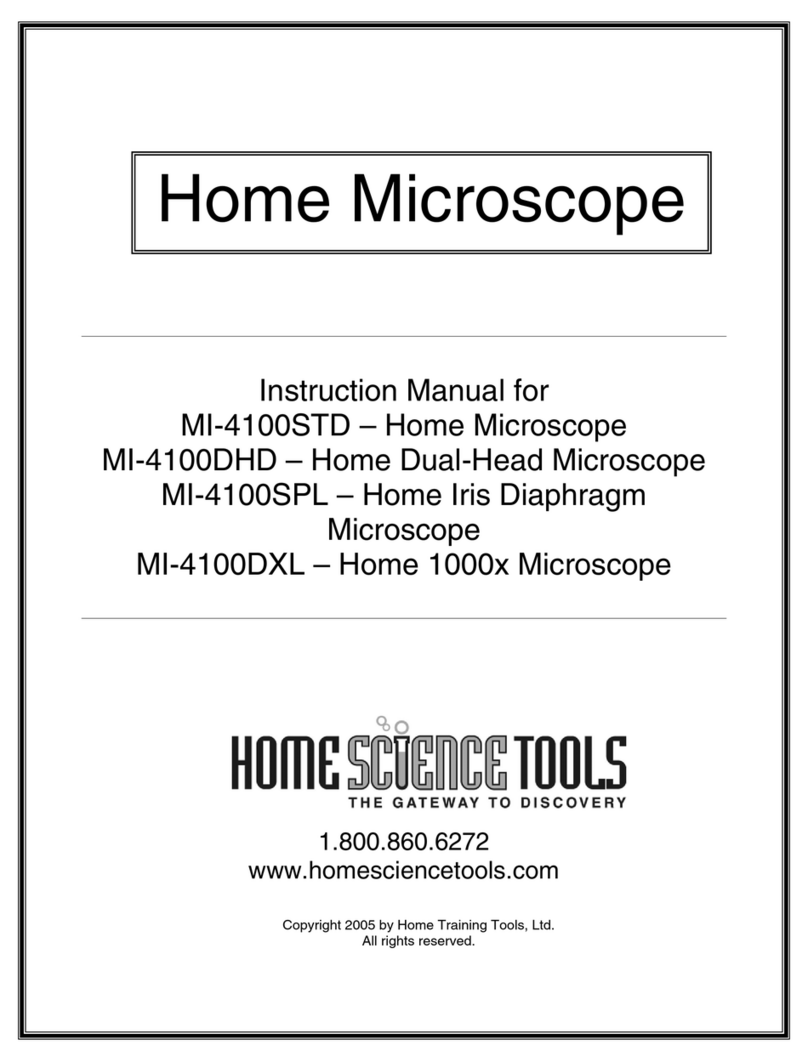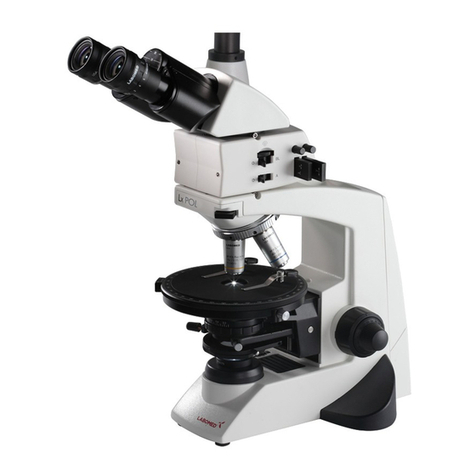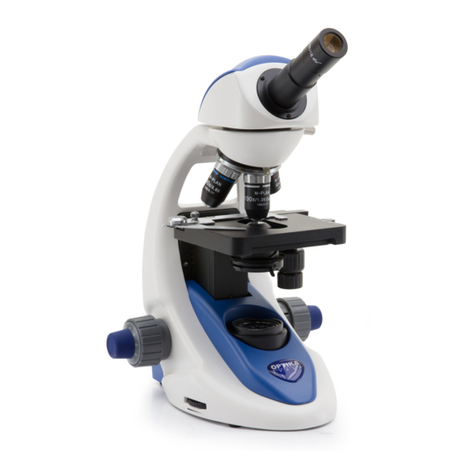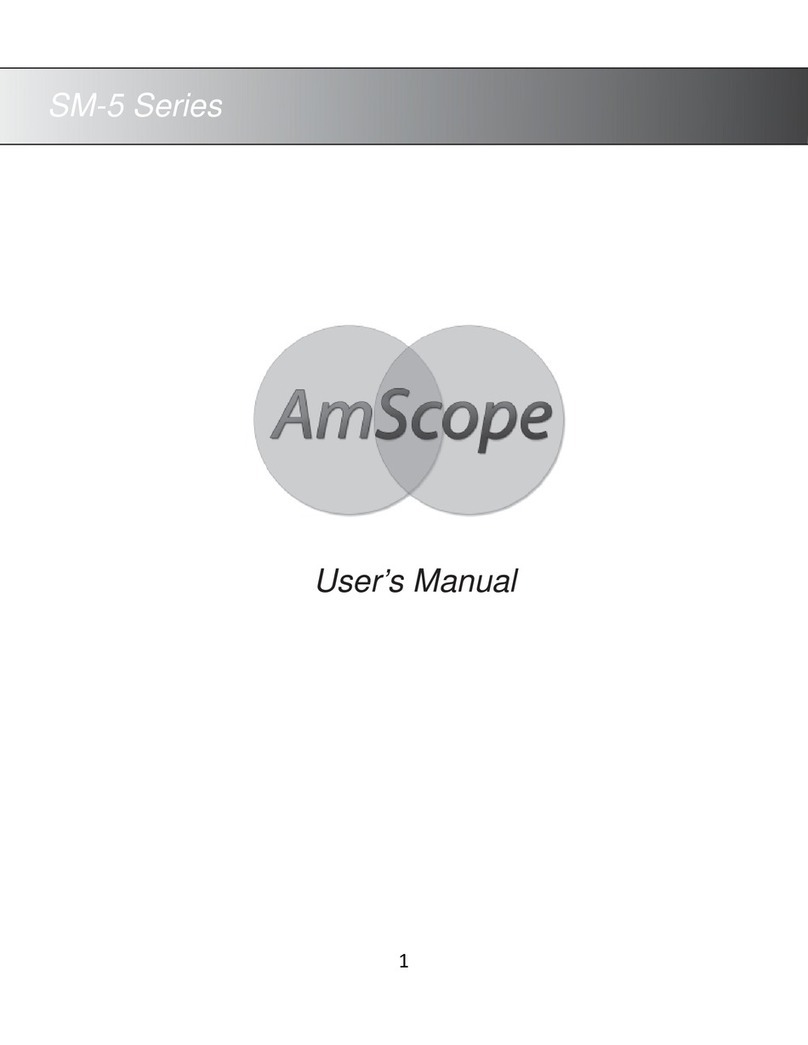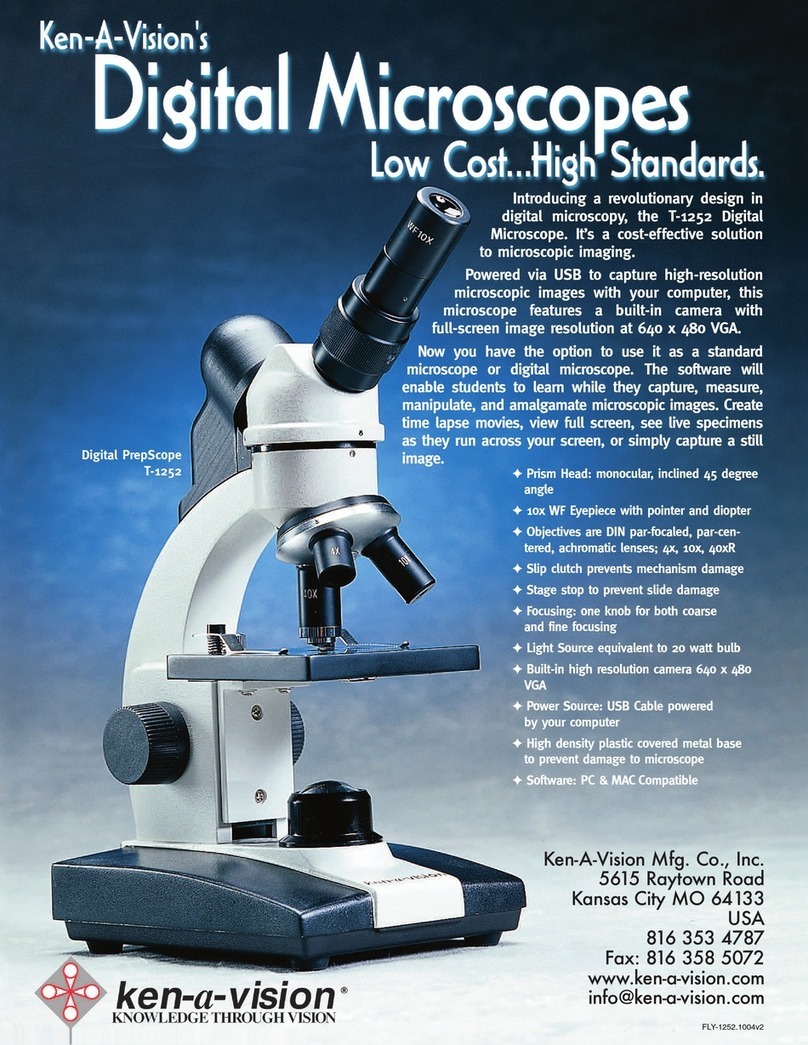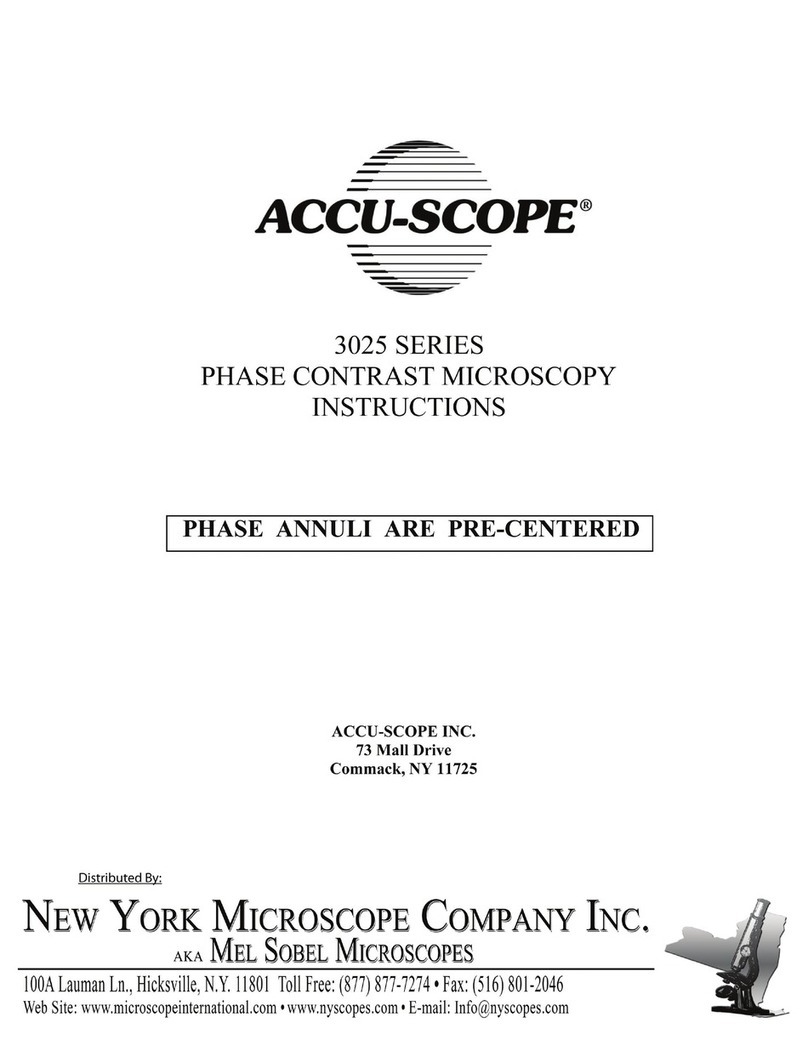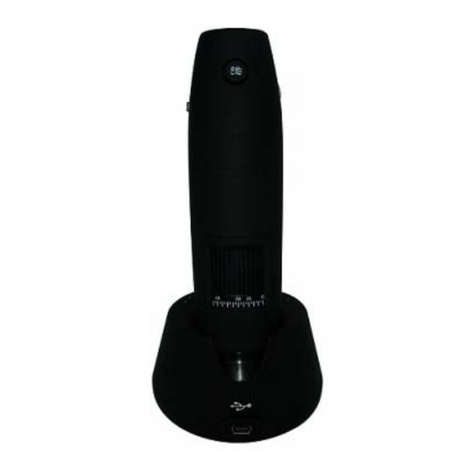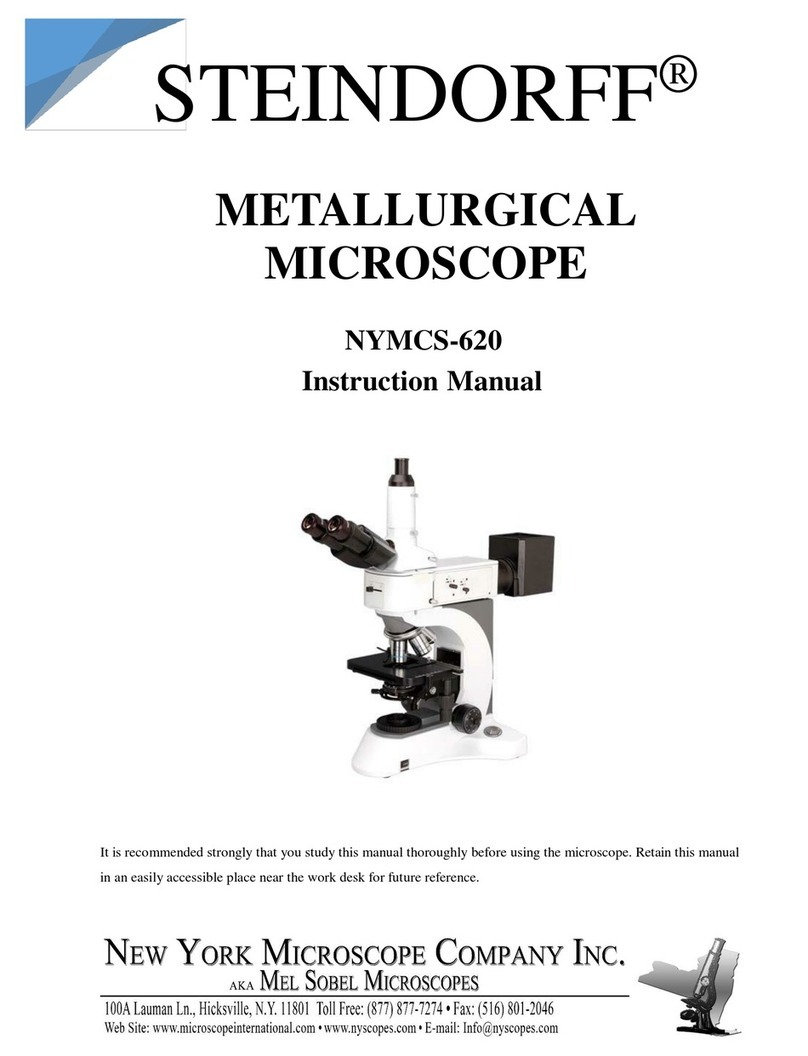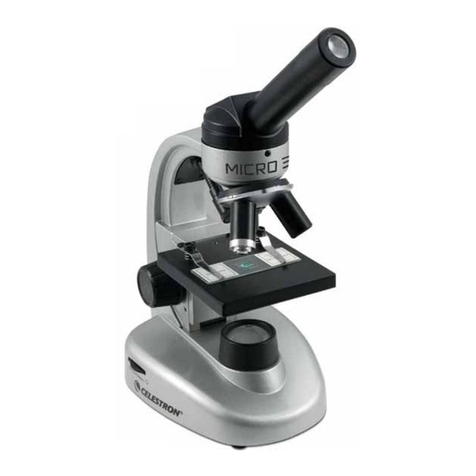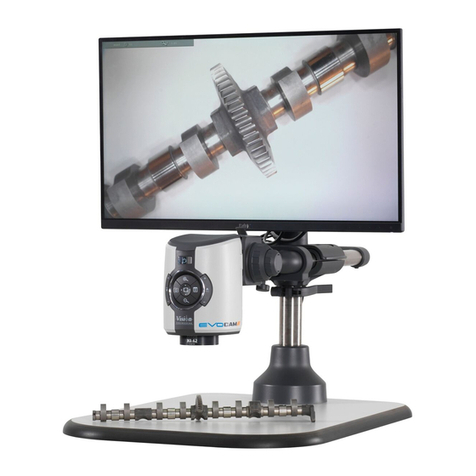Evident SZX16 User manual

INSTRUCTIONS
To ensure the safety, obtain optimum performance and to familiarize yourself full with the use of this
microscope, we recommend that you study this manual thoroughly before operating the microscope.
For details of products included in the configuration of this system, see “1 NOMENCLATURE” (P.4)
and “9 OPERATION OF OTHER MODULES” (P. 22).
RESEARCH HIGH-CLASS STEREO
MICROSCOPE
SZX16
Optical Microscope and Accessory


SZX16
IMPORTANT....................................................................................................................................................... 1
1 NOMENCLATURE.................................................................................................................................... 4
2 CONTROLS................................................................................................................................................... 5
3 SUMMARY OF OBSERVATION PROCEDURE.................................................................. 6
3-1 Preparation.............................................................................................................................................................. 6
3-2 Observation Procedure................................................................................................................................ 6
4 USING THE CONTROLS.................................................................................................................... 7
4-1 Base.............................................................................................................................................................................. 7
1Using the Stage Plate................................................................................................................................................................7
2Placing the Specimen...............................................................................................................................................................7
4-2 Microscope Body and Focusing Assembly............................................................................... 7
1Adjusting the Tension of the Coarse Focus Adjustment Knob ............................................................7
2Engaging and Disengaging the Zooming Knob Click Stop Function ...........................................8
3Adjusting the Aperture Iris Diaphragm.......................................................................................................................8
4Zoom Magnification Indication.........................................................................................................................................9
52X Objective Correction Collar .........................................................................................................................................9
4-3 Observation Tube............................................................................................................................................10
1Adjusting the Interpupillary Distance........................................................................................................................10
2Adjusting the Diopter (Zoom Parfocal Adjustment).....................................................................................10
3Using the Eye Shades ........................................................................................................................................................... 11
4Mounting the Eyepiece Micrometer Disk.............................................................................................................. 11
5Selecting the Light Path ....................................................................................................................................................... 12
6Adjusting the Tilt ......................................................................................................................................................................... 12
4-4 Camera Observation and Photomicrography........................................................................13
1Selecting the Camera Adapter Magnification .................................................................................................. 13
2Mounting the Camera Adapter...................................................................................................................................... 13
3Selecting the Camera Light Path ................................................................................................................................. 13
CONTENTS

5 TROUBLESHOOTING GUIDE ......................................................................................................14
6 SPECIFICATIONS ...................................................................................................................................15
7
OBSERVATION MAGNIFICATIONS AND OBSERVATION AREAS..................................................17
8 ASSEMBLY...................................................................................................................................................18
8-1 Assembly Diagram.........................................................................................................................................18
8-2 Detailed Assembly Procedure.............................................................................................................19
9 OPERATION OF OTHER MODULES......................................................................................22
9-1 Drop Prevention Collar SZX-R and Auxiliary Pillar SZH-P400/SZH-P600 ...........22
9-2 Revolving Nosepiece SZX2-2RE16................................................................................................23
9-3 BX Stage Adapter Type 1 SZX-STAD1 ......................................................................................... 26
9-4 BX Stage Adapter Type 2 SZX-STAD2 ......................................................................................... 27
9-5 Stage Adapter Type 1 SZH-STAD1..................................................................................................29
9-6 Gliding stage SZH-SG................................................................................................................................30
9-7 Cup stage SZH-SC........................................................................................................................................ 31

1
SZX16
IMPORTANT
1. After the equipment has been used in an observation of a
specimen that is accompanied with a potential of infection, clean
the parts coming in contact with the specimen to prevent infection
· Moving this microscope is accompanied with the risk of
dropping the specimen and causing infections. Be sure to
remove the specimen before moving this product.
· In case the specimen is damaged by erroneous operation,
promptly take the infection prevention measures.
· The microscope may become unstable when certain
intermediate attachments and/or photography unit are
mounted on it. Take the measures so that the microscope does
not turn over.
2. To prevent the microscope body from turning over, its left-right pivot
angle must be limited to 30° as shown in figure. The tilt of the
desktop surface should be no more than 5°.
3. Sufficient care is required during observation with a low-magnification
objective, because the objective’s long WD (Working Distance) can
displace the microscope body to a higher position.
The measures for prevention of turning over are also required when
using an auxiliary pillar (SZH-P400/P600), because this also makes
the microscope body to be displaced to a higher position.
4. To adjust the microscope body height, be sure to hold the
microscope body with one hand while loosening the focusing
assembly clamping knob a.
(Use the drop prevention collar (SZX-R) to prevent a hazard from
occurring.)
Be careful not to pinch your finger during the adjustment.
SAFETY PRECAUTIONS
a

2
1Getting Ready
1. A microscope is a precision instrument. Handle it with care and
avoid subjecting it to sudden or severe impact.
2. Do not use the microscope where it is subjected to direct sunlight,
high temperature and humidity, or vibration. (For the operating
environment, see “6 SPECIFICATIONS” (P. 15).)
3. When moving the microscope, remove the specimen in advance.
Then, hold the front part of the base with one hand and hold
the rear part of the base with the other hand to avoid tilting the
microscope.
Also remove any module or attachment from the microscope to
minimize the weight before moving.
4. Observe the following cautions when operating the coarse focus
adjustment knob or the zooming knob.
Operation Manipulated Controls Caution
Focusing Coarse/fine focus
adjustment knobs a
1. If the knob hits the upper or lower
limiting mechanism violently
or it is rotated after it hits a
limiting mechanism, the internal
mechanism may be damaged.
2. If the knobs on the left and right
are rotated in opposite directions,
the internal mechanism will be
damaged. (The rotation tension of
the coarse focus adjustment knob
should be adjusted using the
rotation tension adjustment ring
con the knob. See page 7.)
Zooming Zooming knob b
1. If the knob hits the upper or lower
limiting mechanism violently
or it is rotated after it hits a
limiting mechanism, the internal
mechanism may be damaged.
2. If the knobs on the left and right
are rotated in opposite directions,
the internal mechanism will be
damaged.
5. Only one intermediate attachment can basically be used, but two
attachments may also be used though the peripheral part of the
image may be obscured.
For the coaxial vertical illuminator (SZX2-ILLC16) and reflected
fluorescent light illuminator (SZX2-RFA16), only either can be
attached because they must always be attached at the lowest
position.
a
bc

3
SZX16
2Maintenance and Storage
1. To clean the lenses and other glass components, simply blow dirty away using a commercially available blower
and wipe gently using a piece of cleaning paper (or clean gauze).
If a lens is stained with fingerprints or oil smudges, wipe it gauze slightly moistened with commercially available
absolute alcohol.
Since the absolute alcohol is highly flammable, it must be handled carefully.
Be sure to keep it away from open flames or potential sources of electrical sparks -- for
example, electrical equipment that is being switched on or off.
Also remember to always use it only in a well-ventilated room.
2. The equipment uses plastic resins extensively in its external finish. Do not attempt to use organic solvents to clean
them but simply wipe them using a lint-free, soft cloth. To clean an extremely dirty part, use a soft cloth lightly
moistened with a diluted neutral detergent.
3. Never disassemble any part of the microscope as this could result in malfunctions or reduced performance.
4. When not using the microscope, keep it covered with the dust cover provided. If a module containing a source of
heat is mounted on the microscope, wait until it has cooled down before covering.
5. This equipment should be disposed of by following the rules and regulations of your national or local government.
CAUTION
If the microscope is used in a manner not specified by this manual, the safety of the user may be imperiled. In addition,
the microscope may also be damaged. Always use the microscope as outlined in this instruction manual.
The following symbols are used to set off text in this instruction manual.
CAUTION : Indicates that failure to follow the instructions in the warning could result in bodily harm to
the user and/or damage to equipment (including objects in the vicinity of the equipment).
NOTE
: Indicates that failure to follow the instructions could result in damage to equipment.
TIP
: Indicates commentary (for ease of operation and maintenance).
3Caution
4Intended use
This product has been designed to be used to observe magnified images of specimens in various routine work and
research applications.
This includes the observation of living cells or of specimen taken from tissues to gain physiological or morphological
information at hospitals or laboratories.
Typical field of applications are genetics, human blood and tissue examination, neurology, pharmacology and cellular biology.
Further applications of this device include measurement and imaging for materials research, precision manufacturing, electronics
design and medical device fabrication. Additional industrial applications are added by individual companies and researchers.
Do not use this product for any purpose other than its intended use.
This product complies with the requirements of Regulation (EU) 2017/746 and The Medical Device
(Amendment etc.) (EU Exit) Regulation 2020 concerning in vitro diagnostic medical devices. CE marking
means the conformity to the former, and UKCA marking means the conformity to the latter.
This product is applied with the requirements of EMC standard IEC/EN61326-2-6 and IEC/EN61326-1
concerning electromagnetic compatibility.
This product complies with the emission and immunity requirements described in IEC61326 series. The
electromagnetic environment should be evaluated prior to operation of this product.

4
1
1 NOMENCLATURE
The following illustration shows a typical system composed of modules marked with " " in the list of each
module, and other modules may also be used in place of them. For the modules that are not shown in the
module lists below, please contact us or the latest catalogues.
TIP
Observation tube
Trinocular observation tube :
SZX2-TR30/TR30PT
Tilting trinocular observation tube :
SZX2-TTR/TTRPT
Ergonomic long tilting trinocular:
SZX2-LTTR*
Eyepieces
WHN10X-H
WHSZ15XH
WHSZ20X-H
WHSZ30X-H
Focusing assembly
Coarse/fine focusing assembly: SZX2-FOF
Focusing assembly: SZX2-FO
Coarse/fine focusing assembly for heavy
load: SZX2-FOFH
Motorized focusing assembly: SZX2-FOA2
Motorized fluorescence focusing module:
SZX2-RFA16A*
Base
Standard base : SZX2-ST**
Large base : SZX2-STL**
LED transmitted light illumination:
SZX2-ILLTQ*
SZX2-ILLTS*
Stage plate
Monochrome plate : SZ2-SPBW/SP-BW2
Glass plate : SP-C
Fluorescence center plate : SP-FL
Microscope body
16X zoom microscope body:
SZX2-ZB16
Motorized zoom microscope frame:
SZX2-ZB16A*
Objective
SDFPLFL0.3X
SDFPLAPO0.5XPF
SDFPLAPO0.8X
SDFPLAPO1XPF
SDFPLAPO1.6XPF
SDFPLAPO2XPFC
* A separate instruction manual is available.
*** The standard base (SZX2-ST) requires use of the optional auxiliary pillar (SZH-P400 or SZH-P600) and optional
drop prevention collar (SZX-R). The large base (SZX2-STL) comes with the auxiliary pillar (SZH-P400) mounted as
standard. This enables the large base to be used as is. However, be sure to use the drop prevention collar (SZX-R) in
combination.
load: SZX2-FOFH
Motorized focusing assembly: SZX2-FOA2
Motorized fluorescence focusing module:
Motorized fluorescence focusing module:
SZX2-RFA16A*
Intermediate attachments
Coaxial vertical illuminator :
SZX2-ILLC16*
Vertical fluorescent light illuminator :
SZX2-RFA16*
Extendable eyepoint adjuster:
SZX2-EEPA*
We classify SZX2-ZB16 as an optical microscope and other units as optical microscope accessories.

5
SZX16
If the microscope is not yet assembled, see “8 ASSEMBLY” (P. 18) before the following.
TIP
Light path selector knob (P.12)
Zooming knob
0.7X to 11.5X
Coarse focus adjustment knob
tension adjustment ring (P.7)
Fine focus adjustment knob
(SZX2-FOF/FOFH)
Stroke: 80 mm
Stroke per turn: 0.77 mm
Coarse focus adjustment knob
Total Stroke: 80 mm
Stroke per turn (SZX2-FOF/FOFH): 36.8 mm
Stroke per turn (SZX2-FO): 21 mm
Focusing assembly
clamping knob
Specimen holder
Locks the specimen.
Diopter adjustment
ring (P.10)
±5m-1 (per meter)
Aperture iris diaphragm ring (P.8)
Diopter adjustment
ring (P.10)
±5m
-1
(per meter)
(per meter)
Eyepiece clamping knob
Click stop ON-OFF screw (P.8)
Engages or disengages the click stop
function for each zoom magnification.
2
2 CONTROLS
(per meter)
Aperture iris diaphragm ring (P.8)
Eyepiece clamping knob
Zoom magnification
indication (P.9)
0.7 to 11.5 (14 indications)

6
3
3SUMMARY OF OBSERVATION PROCEDURE
Ref. Page
1. Check and tighten the connection of each component, especially the observation tube...........................................................................(Page 20)
2. Check that the angled formed by the microscope body with respect to the base
is less than the turning-over prevention angle........................................................................................................................................................................................................(Page 19)
3. Adjust the tension of the coarse focus adjustment knob............................................................................................................................................................................(Page 7)
4. Confirm the correct settings.
3-2 Observation Procedure
3-1 Preparation
Place a specimen on the stage. (Page 7)
Adjust the interpupillary distance. (Page 10)
1
2
Make diopter adjustment of the eyepieces. (Page 10)
(
The adjustment procedure is variable depending on
whether the eyepiece micrometer disk is used or not.
)
3
Set the zooming knob ato the lowest zoom magnification and bring
the microscope into focus by rotating the coarse focus adjustment
knob b.
Rotate the zooming knob ato the desired magnification and
precisely focus the microscope on the specimen with the coarse
focus adjustment knob band fine focus adjustment knob c(the
fine focus adjustment knob is not provided with the SZX2-FO).
The contrast of the observed image and the focal depth of the
specimen can be adjusted with the aperture iris diaphragm
ring.
4
5
TIP
a
b
c

7
SZX16
4
4 USING THE CONTROLS
4-1 Base
4-2 Microscope Body and Focusing Assembly
In reflected light observation, the stage plate can be placed either the
white or black side facing up.
Win transmitted light observation, use the transparent
glass stage plate (SP-C).
NOTE
This operation is intended to facilitate the rotation of the knobs
while preventing the spontaneous drop of the microscope
body. It is recommended to set the knob tension to a slightly
higher level than the point where spontaneous drop occurs.
If the knobs are hard to move because of the weight of option
modules and/or camera mounted on the microscope body, it
is recommended to use the focusing assembly for heavy load
(SZX2-FOFH).
The tension of the coarse focus adjustment knob can
be adjusted with the tension adjustment ring a. Do
not rotate the knobs on the left and right in opposite
directions, for this will damage the internal mechanism.
Rotate the tension adjustment ring aby inserting the Allen
screwdriver cinto the hole bon the ring periphery.
Rotating the ring clockwise increases the tension of the coarse
focus adjustment knob, and rotating counterclockwise decreases it.
·If the microscope body falls down by its own weight or
the focus obtained by fine focusing is lost immediately, the
tension adjustment may be too light. In this case, rotate the
ring clockwise to increase the tension.
·If the tension adjustment is too tight, delicate focusing will
be impossible and the knob may be damaged. Particularly,
to prevent damage, never rotate the fine focus adjustment
knob quickly while its tension is extremely tight.
TIP
NOTE
1
NOTE
Place the specimen on the approximate center of the stage plate. Hold
the specimen with the specimen holder as required.
Illuminate the specimen with an illuminator selected according to the
specimen under observation.
1
2
1Using the Stage Plate
1Adjusting the Tension of the Coarse Focus
Adjustment Knob
2Placing the Specimen
a
b
c1

8
· When the click stop knob is set to ON, the click stop function
is engaged for each magnification indicated with the zooming
knob. When the knob is set to OFF, the zoom magnification
can be varied continuously and finely near the click groove.
The click stop knob has been set to OFF before the
microscope is shipped from the factory.
· A click stop is provided for each of the 12 intermediate
indication positions of the zoom microscope body.
To engage the click stop function, rotate the click stop ON-OFF screw a
fully clockwise (in the direction of the arrow) using the Allen screwdriver.
The zooming knob then stops at every position corresponding to the
magnification indicated on the zoom magnification indication b.
To disengage the click stop function, rotate the click stop ON-OFF
screw afully by three turns from the ON position, in the direction
opposite to the arrow, using the Allen screwdriver.
Do not rotate the screw too much, or the cover may be
damaged.
TIP
1
2
NOTE
Adjusting the aperture iris diaphragm increases the contrast of
the observed image as well as the depth of focus.
However, setting the aperture iris diaphragm too narrowly
degrades resolution.
Adjust the aperture iris diaphragm ring ato the left or right.
Rotating the ring toward the left ( ) opens the aperture; rotating it
toward the right ( ) closes it. Adjust while monitoring the observed
image to confirm the contrast and focal depth improvement effects.
Do not close the aperture too much, for this may cause
degradation in resolution and/or lack of ambient light.
Use the scale gradations as references for memorizing the ring position.
When the microscope is combined with the coaxial
vertical illuminator (SZX2-ILLC16), minimizing the aperture
may obscure a part of the observed field of view. In this
case, open the aperture to an intermediate position.
TIP
1
NOTE
2
NOTE
3Adjusting the Aperture Iris Diaphragm
a
a
b
2Engaging and Disengaging the Zooming Knob
Click Stop Function
2

9
SZX16
The body zoom magnification ais indicated on the zooming
knob on the right side.
The total magnification of observation can be calculated with the
following formula:
Objective
magnification xBody zoom
magnification xEyepiece
magnification
·The SDFPLAPO2XPFC objective is provided with a correction
collar afor use in compensating for the aberration caused due
to the observation medium such as water and plastic container.
When observing a specimen in a liquid or through a petri dish
cover, turn the collar to obtain the optimum contrast.
·Correction is possible for aberration corresponding to
water depth of about 5 mm.
·The correction effect may be less tangible when the
zoom magnification is low or the aperture iris diaphragm
is stopped down.
·When using the SZX2-2RE16 revolving nosepiece, hold
the objective during rotation of the ring so that the revolving
nosepiece is not deviated the click position.
TIP
4Zoom Magnification Indication
52X Objective Correction Collar
a
a
Water
depth:
5 mm
or less

10
Be sure to hold the binocular assembly awith both
hands to make this adjustment.
To prevent damaging the mechanism, do not apply an
excessive force beyond the stop position.
While looking through the eyepieces, hold the left and right of the
binocular assembly aand adjust the eyepieces by opening or
closing them for binocular vision until the left and right fields of view
coincide completely.
NOTE
Ensure that the eyepiece clamping knob ais tightened
before starting the adjustment.
Adjusting the diopter specific to the two eyes of each
observer allows the parfocality to be ensured across zoom
magnifications.
When Not Using the Eyepiece Micrometer Disk
Look into the right eyepiece and rotate its diopter adjustment ring b
so that the peripheral part of the visual field looks sharply.
Place an easy-to-observe specimen on the stage plate.
Rotate the zooming knob cto a low magnification and, looking only
into the right eyepiece, focus the specimen using the coarse and fine
focus adjustment knobs.
Rotate the zooming knob cto the highest magnification and, looking
only into the right eyepiece, focus the specimen using the coarse and
fine focus adjustment knobs.
Rotate the zooming knob cto the lowest magnification, look only
into the left eyepiece, and focus the specimen by rotating the left
diopter adjustment ring dinstead of the coarse and fine focus
adjustment knobs.
When Using the Eyepiece Micrometer Disk
Look into the right eyepiece that includes the eyepiece micrometer
disk, and focus the micrometer disk by rotating the diopter adjustment
ring b.
Place an easy-to-observe specimen on the stage plate.
Rotate the zooming knob cto the highest magnification and,
looking only into the right eyepiece, focus the specimen using the
coarse and fine focus adjustment knobs.
Ensure that both the eyepiece micrometer disk and specimen are
focused accurately.
TIP
1
2
3
4
5
1
2
3
1Adjusting the Interpupillary Distance
2Adjusting the Diopter (Zoom Parfocal Adjustment)
a
4-3 Observation Tube
a
d
bc

11
SZX16
When Wearing Eyeglasses
Use with eye shades in their normal folded-down position. (This will
prevent eyeglasses from being scratched by the eyepiece.)
When Not Wearing Eyeglasses
Extend the folded eyeshades in the direction of the arrow. This makes
observation easier by preventing the inverse incidence of light from
between the eyepiece and your eyes.
· A variety of eyepiece micrometer disks can be inserted into
the WHN10XH, WHSZ15X-H and WHSZ20X-H eyepieces.
Use 24 mm dia. x 1.5 mm thick micrometer disks.
Following figure, turn the built-in micrometer-mounting frame
bto the arrow direction to remove it from the eyepiece and
place a micrometer disk ainto the mounting frame so that
the surface with the model indication faces downward.
· The micrometer-mounting frame may be tight for certain
micrometer disks.
In this case, turn the frame by holding the circumference
with a light, uniform force or by applying the frame against a
rubber sheet. Do not grasp the frame with a strong force, as
this may deform the frame and make it harder to remove it.
Re-attach the micrometer mounting frame in the original
position.
· Be careful not to touch the lens surface with your finger.
The WHSZ20X-H eyepiece is designed to apply a
magnification to the focusing plane of the micrometer disk.
As the magnification coefficient is 1.35, be sure to perform
magnification compensation when using this eyepiece in
measurement.
When the micrometer disk is engaged in their light path,
the light path length will extend and the diopter scale may
deviate toward the + direction from the normal indication.
However, this does not pose any problem in actual
observation.
When the eyepiece micrometer disk is not used, wrap it in a
clean sheet of soft paper before storage.
TIP
Note
TIP
3Using the Eye Shades
4Mounting the Eyepiece Micrometer Disk
b
a
WHN10X
Rotate the zooming knob cto the lowest magnification, , look
only into the left eyepiece, and focus the specimen by rotating the
left diopter adjustment ring dinstead of the coarse and fine focus
adjustment knobs.
Note (or memorize) the diopter readings of the left and right
eyepiece scales so that they can be duplicated quickly in the
next observation.
4
TIP

12
Pull out the light path selector knob ato set the light path
for the right eyepiece to the camera light path. (The following
table shows the intensity ratio of each light path in %.)
Light Path Selector
Knob Pushed-in Pulled-out
SZX2-TR30
SZX2-TTR
()
Right Binocular 100%
Binocular 50%
Camera 50%
Left Binocular 50%
SZX2-TR30PT
SZX2-TTRPT
()
Right
Binocular 100%
Camera 100%
Left Binocular 100%
Always push or pull the light path selector knob aall the
way into a stop position. Do not attempt to force the knob
past the stop position. Applying excessive force could
destroy the mechanism.
TIP
NOTE
Adjust the height and tilt of the observation tube to the most
comfortable viewing position.
Holding the binocular assembly with both hands, raise or
lower it to the desired position.
Do not attempt to force the binocular assembly past the
upper or lower stop position. Applying excessive force
could destroy the mechanism.
TIP
NOTE
5Selecting the Light Path
6Adjusting the Tilt
a

13
SZX16
4-4 Camera Observation and Photomicrography
Set the magnification of the camera adapter according to the size of the CCD in the digital camera.
(Example) The following figures show the camera observation/photomicrography areas when the WHN10X
eyepieces with FN 22 are used.
A digital camera unit can be mounted on the straight tube mount of the trinocular tube by means of the camera
adapter and/or camera mount adapter*.
* The camera mount adapter is not necessary if a camera adapter equipped with a camera mount is used.
For details, please also read the instruction manuals for the camera adapter and digital camera.
Using the Allen screwdriver, fully loosen the straight tube clamping
screw aof the straight tube mount on the top of the trinocular tube.
Fit the round dovetail bof the camera adapter into the straight tube
mount of the trinocular tube, and tighten the clamping screw a.
Mount the camera on the camera adapter. A camera mount adapter
may be required with certain camera adapters.
1
2
3
Pull out the light path selector knob cto select the Binocular 50%/
Camera 50% light path setting for the SZX2-TR30/TTR or the Camera
100% light path setting for the SZX2-TR30PT/TTRPT.
1Selecting the Camera Adapter Magnification
2Mounting the Camera Adapter
3Selecting the Camera Light Path
1 in. CCD
2/3 in. CCD
1/2 in. CCD
WHN10X
FN 22
When the 0.5X camera adapter is used When the 1X camera adapter is used
a
c
b

14
Problem Cause Remedy Page
1. The left and right fields of view do
not coincide.
The interpupillary distance is
adjusted improperly.
Adjust it correctly. 10
The diopter is adjusted incorrectly. Adjust it correctly 10
The left and right eyepieces are
different.
Use a pair of matched eyepieces. 21
2. The field of view is obscured
partially or illuminated unevenly.
The aperture iris diaphragm is
stopped down excessively.
Open the aperture iris diaphragm. 8
The trinocular observation tube
and/or intermediate attachments
are installed improperly.
Mount them properly.
20
The light path selector knob is in
an intermediate position.
Set it correctly to the desired
position. 12
3. The monitor image is cut off
partially.
The light path selector knob is
pulled out incompletely.
Pull it out all the way. 12
4. Dirt or dust is visible in the field
of view.
Dirt/dust on the specimen. Clean thoroughly. 3
Dirt/dust on eyepiece. Clean thoroughly. 3
5. Details of observed image are
solid.
The aperture iris diaphragm is
stopped down excessively
Open the aperture to a proper
diameter. 8
6. Visibility of observed image is
poor.
· Image is not sharp.
· Contrast is insufficient.
The objective is tilted. Screw it correctly until it stops. 20
The objective is dirty. Clean thoroughly.
3
The top and/or bottom lenses of
the microscope body are dirty.
7. Zooming causes defocusing of
the observed image
The eyepiece diopter is adjusted
improperly.
Adjust it correctly. 10
The focus adjustment is in
accurate.
Adjust focus at a high
magnification. 10
8. The coarse focus adjustment
knob does not rotate smoothly
The rotation tension of the knob is
set too high.
Decrease the rotation tension to
an optimum level. 7
9. The microscope body drops
spontaneously, causing the
focusing to be deviated during
observation.
The rotation tension of the coarse
focus adjustment knob is set too
low.
Increase the rotation tension to
an optimum level. 7
The microscope body dropped
spontaneously because the weight
exceeded 10 kg.
Use a focusing assembly
withstanding heavy loads.
(SZX2-FOF: 2.7 to 15 kg.
SZX2-FOFH: 8 to 25 kg.)
15
55TROUBLESHOOTING GUIDE
Under certain conditions, performance of this unit may be adversely affected by factors other than defects. If a problem
occurs, please review the following list and take remedial action as needed. If you cannot solve the problem after
checking the entire list, contact us.

15
SZX16
66SPECIFICATIONS
Item Specifications
(1) Zoom microscope body
· SZX2-ZB16
Left/right zoom magnification system.
Zoom drive system: Horizontal knob.
Click stop ON-OFF switchable per zoom magnification.
Zoom ratio: 16.4 (0.7X to 11.5X)
Magnification indications: 14 indications. 0.7, 0.8, 1, 1.25, 1.6, 2, 2.5, 3.2, 4, 5, 6.3, 8, 10, 11.5.
Objective mount: Threaded mount
Built-in aperture iris diaphragm.
(2) Focusing assembly
· SZX2-FOFH
· SZX2-FOF
· SZX2-FO
SZX2-FOFH SZX2-FOF SZX2-FO
Focusing system: Rack & pinion roller guide
(with coarse focus adjustment knob tension adjustment ring).
Built-in gas spring counter
balance.
Coaxial coarse/fine focus
adjustment knobs.
Built-in counter balance.
Coaxial coarse/fine focus
adjustment knobs.
–
Coarse focus adjustment knob
only.
Coarse focus adjustment knob stroke: 80 mm
Coarse knob stroke per turn: 36.8 mm
Coarse knob stroke per turn : 21 mm
Fine focus adjustment knob stroke: 80 mm
Fine knob stroke per turn: 0.77 mm
–
Load: 8 to 25 kg Load: 2.7 to 15 kg Max. load: 10 kg
(3) Observation tube
· SZX2-TR30
· SZX2-TR30PT
· SZX2-TTR
· SZX2-TTRPT
SZX2-TR30 SZX2-TR30PT SZX2-TTR SZX2-TTRPT
Trinocular observation tube. Tilting binocular observation tube.
Tube inclination: 30° Tube inclination: 5° to 45°
Light path selection:
2 steps.
(Binocular 100%,
Binocular 50% /
Camera 50%)
Light path selection:
2 steps.
(Binocular 100%,
Camera 100%)
Light path selection:
2 steps.
(Binocular 100%,
Binocular 50% /
Camera 50%)
Light path selection:
2 steps.
(Binocular 100%,
Camera 100%)
Interpupillary distance adjustment: 52 to 76 mm.
Eyepiece clamping knobs provided.
Eyepieces: WHN10X-H, WHSZ15X-H/20X-H/30X-H
(4) Standard base
· SZX2-ST
Pillar support sleeve height: 270 mm.
Base dimensions: 284(W) x 335(D) x 31(H) mm.
Specimen holder attachable.
With stage adapter mounting holes.
(5) Large base
· SZX2-STL
Pillar height: 400 mm.
Base dimensions: 400(W) x 350(D) x 28(H) mm.
Specimen holder attachable.
With stage adapter mounting holes.
Drop prevention collar: Optional SZX-R.

16
Item Specifications
(6) Objectives
WD : Working distance
PF : Parfocal lens
SDFPLFL0.3X
SDFPLAPO0.5XPF
SDFPLAPO0.8X
SDFPLAPO1XPF
SDFPLAPO1.6XPF
SDFPLAPO2XPFC
WD 141 mm*
WD 70.5 mm
WD 81 mm
WD 60 mm
WD 30 mm
WD 20 mm
(7) Eyepieces
(Note) The micrometer area
outside the FN is
invisible.
WHN10X-H ** FN 22, diopter adjustment ring provided.
WHSZ15X-H ** FN 16 diopter adjustment ring provided.
WHSZ20X-H ** FN 12.5 diopter adjustment ring provided.
WHSZ30X-H FN 7 diopter adjustment ring provided.
(8) Operating environment · Indoor use.
· Altitude: Max. 2,000 m.
· Ambient temperature: 5°C to 40°C. (41°F to 104°F)
· Maximum relative humidity 80% for temperatures up to 31°C (88°F), decreasing linearly
through 70% (at 34°C), 60% (at 37°C) to 50% (at 40°C).
* Auxiliary pillar is required when the SZX2-ST is used
** Ø24 mm dia., 1.5 mm thick eyepiece micrometer disk can be inserted.
Table of contents
Other Evident Microscope manuals

